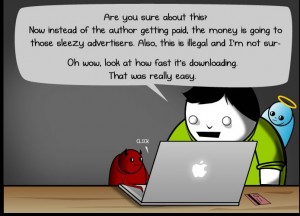I’ve told you what I think of the book. Now I’d like to examine my own information diet, as part of my personal process of rethinking it.
Google Reader
I am not someone who gets a lot of emails on a daily basis–I’m simply not that popular. So for many years, Google Reader was my primary dashboard for information consumption on the web. Social media has grown in relative importance, but I’ll go into that a little further down.

Reader is still my first stop when I wake up in the morning. I think of it as akin to the old habit of reading the newspaper in the morning before work–except that I have complete control over the composition of that newspaper. I even have my own comic section, made up of the webcomics I have found since I first discovered the form back in High School.
I’ve been using Reader since 2005, but my subscriptions look quite different from what they were then. For one thing, there is no longer any politics folder. The closest I get to politics are the DC blogs I read who cover some of the politics in my city, and the econ bloggers who occasionally comment on national policy debates. I also read a lot more about technology than I used to.
One of the nice things about Reader is that it provides me with data about my subscriptions.

For instance, the total number of subscriptions I have, as well as their output in terms of individual “items” (usually a post from a blog) over a 30 day period. Brace yourself, it is a lot.

That is an average of 262 items per day; though in general that means a lot more on week days and a lot fewer during the weekend. That’s a lot of items, and I don’t think that this would be a good information diet for most people. But I think this works for me. I may be rationalizing, but for the vast majority of those nearly 8,000 posts I just glimpse at the headline of to see if it’s something I’m going to be interested in, and then move on. There are a few blogs that I will give more of a chance to absolutely anything they write–usually people I know personally or very interesting but very low output writers.
Just look at how few of them I actually click on–388 items. While this isn’t the best measure of what I actually read, since some feeds give me full posts without having to click through, it’s a decent proxy for the bigger producers. It’s only around 13 posts a day, a far more manageable number. I would say the true number is probably more like 20-30 on average. Of those, maybe 5-10 are of any great length.
The producers of content are highly concentrated; there is a power law distribution across my subscriptions.

The top ten highest producing subscriptions account for an average of 191 posts a day; about 73 percent of the total items in my Reader account per day. The main value of Reader, in my opinion, is for following those other 199 subscriptions, which may update less than once a day, maybe even less than once a week or once a month. I don’t have to go to them to see when they’ve updated; their updates come to me. So if I wanted to think about scaling back, the top 10 subscriptions would be the place to do it.
By far the biggest producer is The Verge. An average of over 50 posts per day! This fluctuates depending on what’s going on in the tech world; when I looked at it a few weeks ago they were around 40 posts per day. Most of the posts are what Clay Johnson might call empty calories; quick updates about the tech industry that don’t have much additional content beyond a company announcement or the latest rumor. I have no problem skipping over nearly all of those posts, though occasionally I’ll find one to be interesting.
I’ve written elsewhere on what I like about The Verge’s general approach, but I’ll summarize it here briefly. I have followed the main cast of characters there since they were the head editorial staff at Engadget, and I think they get what it means to be at the heart of a web community. I enjoy listening to their podcast, as much for the personalities of the people as for the specific things they talk about. I trust them not to bullshit me. And I like that they invest in writing long form, visually rich feature pieces on quirky topics like this one.
As part of the process of rethinking my information diet, I’ve contemplated whether there’s a more fine-tuned way to approach my subscription to The Verge. They have RSS feeds for specific topics, for instance; I could cut down on some of the stuff I’m less interested in. But the fact of the matter is that I like being exposed to a broad swatch of technology topics, and I don’t think I’m sacrificing all that much to do so.
I did take all of the top 7 producers out of any folder to stand on their own, so that my other subscriptions wouldn’t be buried by sharing a folder with them. I also learned years ago that the only healthy way to use Google Reader is to give yourself permission to just click “mark all as read” when you don’t feel like going through everything. Breaking out the big produces allows me to mark each of them as read more easily while leaving the smaller, individual blogs that I like to look at later.
io9, Boing Boing, and Lifehacker are about equivalent in their output, and I did think about whether I wanted to unsubscribe to any of them. But when it comes to the cost of subscribing to them, it’s the same story as it was with The Verge–I find it nearly effortless to skip over all the stuff that doesn’t look like it’s going to be of interest. And when I hit a gem on any of these three, it’s usually something really good. For instance, this very interesting post from io9. So I think these are still keepers, at least for the time being.
The Daily Dot I’m less confident in. It’s a perfectly fine publication, but most of the things they cover I am either not interested in, or I’ve seen covered elsewhere. I really only started following it because I wanted to keep an eye on what my friend Lauren, who writes there, was up to. Acknowledging this, I unsubscribed from the main feed and now am subscribed to her feed specifically. That takes it down from around 19 posts a day to more like 3; few enough that I can just shuffle it off to my Media Analysis folder.
Those are the big ones. Before writing this post, I also unsubscribed from ReadWriteWeb, since I felt their quality had been on the decline for a while and most of what they cover is already covered by The Verge. They were another big producer, so that helped. Another way that I improved my information diet was to cut out MG Siegler from it entirely. That decision was inspired by two episodes of Triangulation: the interview with Clay Johnson, and the interview with Gina Trapani. Gina said that the tech blogosphere often seemed like one big male pissing match. Afterwards, I read this post by Siegler and just decided I did not need to invite that kind of crap into my life.
Podcasts
Back in 2008, I took a job that was in Columbia, Maryland, which was a 40 mile drive from Vienna, Virginia, where I was living at the time. Shortly afterwards, I started grad school, the night classes for which took between an hour and a half to over two hours to get to from my job, depending on which campus the class was on and how bad traffic was. Oh, and I started seeing someone in Washington, DC.
In short, I spent an enormous amount of time driving, and podcasts became not only a big part of my information diet, but an important part of keeping up my quality of life. If I hadn’t had my podcasts during those long days on the road, I would have gone insane.
Nowadays, I’m living in DC with my fiancée, I’m done with grad school, and I took a job in Fairfax City–still about a 45 minute commute, but not nearly as insane as it used to be. My podcasts are still an essential part of my commute. I’m pretty proud of this part of my information diet; there isn’t a single podcast here that does anything but enrich my information consumption experience.
I use Downcast for the iPhone as my podcatcher.

Pictured here are four of the short story podcasts that I listen to. Podcastle and Pseudopod are part of the Escape Artists podcast family; a nonprofit group of three podcasts that post a new story each week. They specialize in fantasy and horror respectively, and the third podcast, Escape Pod, specializes in science fiction. The Drabblecast is a weekly weird fiction podcast that I started listening to more recently, and it is a lot of fun. The Dunesteef Audio Fiction Magazine is less consistent in its updates, but I enjoy it in part because it is just a couple of friends who decided to get together and start putting out a short fiction podcast. They don’t focus on any one genre, and the conversations after the story give it the feel of hanging out with two friends you’ve known your whole life.
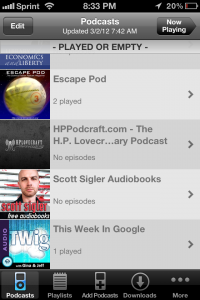
I recently wrote about Scott Sigler, the man who pioneered the podcast novel. There was a time when most of what I was listening to on my commute were podcast novels, and I still follow Sigler’s as he releases new installments each week. There are also a couple of authors I’m looking forward to seeing podcast novels from, such as R. E. Chambliss, who is working on a sequel to her excellent fantasy novel, Dreaming of Deliverance.
The H.P. Lovecraft Literary Podcast is just fantastic. Each week, the co-hosts and occasional guest discuss one of Lovecraft’s works, which they have been going through in the order that they were written for nearly three years now. I started it by going through the archive at the rate that I was capable of reading each story and then listening to the episode. I’ve been caught up for a while now, and really love the show. It’s like a free literature class in my car that I can partake of whenever it’s convenient for me. It also has the same element as the Dunesteef, where the co-hosts are good friends and their conversation is fun to listen to.
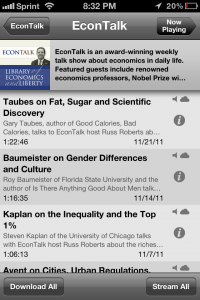
I started listening to Econtalk back when I was taking a class taught by its host, Russ Roberts. This is brain food of the highest order. It is ostensibly about economics but in practice discusses just about every intellectual topic under the sun. I am a lot smarter for having listened to it for the last four years.
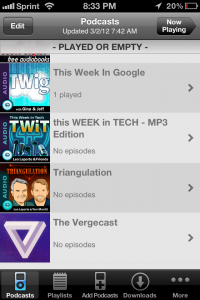
And then there are my tech podcasts. Back in the day, I considered the Engadget Podcast to be essential listening for my week. The exact same cast of characters now hosts The Vergecast, and it still has the elements that I loved about its predecessor. But I’m at a point now where I give myself permission to just skip the tech podcasts some weeks, especially if I’ve been catching up on fiction. I don’t really listen to TWiT at all unless there’s some special topic they’re discussing that I want to hear their take on. I’m a fairly faithful TWiG listener, and I pick and choose which Triangulation episodes I listen to based on who is being interviewed.
Social Media
The various social streams that I’ve set up on places like Twitter and Facebook are a big part of my web experience.
Of them all, Twitter remains my favorite.

I follow a lot of people; 531 at this moment. I treat Twitter as my index of interesting people with of many different backgrounds and viewpoints. I don’t feel the need to stay current with all or most, or even a large minority of them. The “mutual follows” – people who I follow that follow me back – is a much smaller core of people, and the people I talk to the most number maybe 15-20. I make use of Twitter’s lists feature to occasionally check up on them specifically.
I love Twitter, I really do. I have made more new friends on Twitter than I have any other single place on the web. There’s something about the structure of how conversations take place there that is just wonderful, and difficult to explain to people who aren’t using it. There’s a lot of serendipity as well; people respond to things you didn’t expect them to, or suddenly two people you follow are talking to each other and you hadn’t even realized they knew the other existed.
The other big social network I use is Facebook.
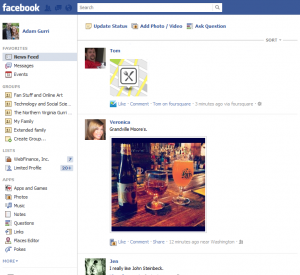
I used to be very wary of Facebook, back when I first joined it. I think I deleted my account three or four times before I finally embraced it. The event that crystallized it for me was when I was in a friend’s wedding a few years ago. Afterwards, everyone who had been in the wedding party friended one another and started sharing pictures of the wedding. I suddenly saw just how useful Facebook could be.
I have since customized my Facebook experience to make it work for me. Most of the stuff I post goes into groups rather than the main feed. My favorite is a group I created with my friends and siblings to talk about video games, science fiction, art, and general geek things. We have so much fun there that we’ve all been bringing in more and more people to join in. My experience in that group is, to my mind, the pinnacle of what social media is at its best.
A much smaller part of my social media activity happens on Tumblr.
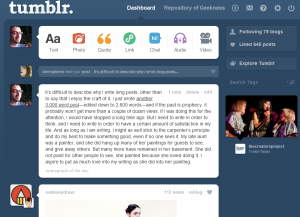
Part social network, part publishing platform, part feed reader, I like Tumblr’s style. I don’t follow very many people on there, but I have found a few fun artists that post there to follow.
Finally, there’s Google+. I was excited about it when it came out, but to be honest, I don’t really spend time on it any more. There are a few very specific reasons I haven’t abandoned it entirely:
- The integration with Google Reader makes it effortless for me to share stuff I find interesting there.
- There are a handful of people I like interacting with who are still very active there, and that’s the main place I end up talking to them.
- Robert Scoble once put me in a suggested circle – with 400 other people – therefore I have four times as many followers there as I have on Twitter. Hard to resist the pull of attention.
But it’s a vanishingly small part of my information diet.
Offline
The biggest non-web portions of my information diet are books, TV, and movies.
I don’t watch as many TV shows as I used to. My fiancée and I will occasionally find a show to watch through on Netflix, and we’ll usually be following one or two shows that are going on right now. For the life of me I can’t think of any that didn’t begin by watching the first seasons on Netflix or Hulu, though. In general I am a genre guy; I like my science fiction, fantasy, and horror. But truth be told I haven’t been as up on it lately as I was in, say, college.
We occasionally go out to the movies and generally try to find a movie to watch on Netflix, Amazon, or TV Friday or Saturday night.
I read a lot of books. This has always been true, especially back when I was working at Borders. And since I got a Kindle last year, it’s been that much easier to get and read books.
And I do find it much easier to read on the Kindle than to read on a computer or even to read a physical book. It is much lighter to hold and much less unruly than a real book – there’s no accidentally losing your place – and lacks all the distractions that the computer comes with.
The kinds of book I read range from…well, The Information Diet and books like Here Comes Everybody, to the Dresden Files books and other genre fiction. I don’t think the book part of my information diet really needs any work.
Major Lessons from the Book
The most important thing that I took from the book had less to do with the content of my information diet and more to do with the time I spent on it. I definitely get into the bad habit of checking things compulsively. In particular, my email, Google Reader, Twitter, Facebook, and Tumblr. One thing I am going to set out to do is create bigger buffers between when I let myself check for updates.
I also did decide to scale back on some of my RSS subscriptions, but ultimately I think I’m in a healthy place with them. They don’t rule my life, and I’m content to mark all as read and miss what I miss.
Reading the book made me think that it would be a good idea to do this sort of audit of my information diet. I did make some changes, but not many drastic ones, which has me wondering if I’m too close to it. So if you’re still with me, these 3,000 words later, I’m asking: do you think I should make any changes to my information diet? Am I information obese?
